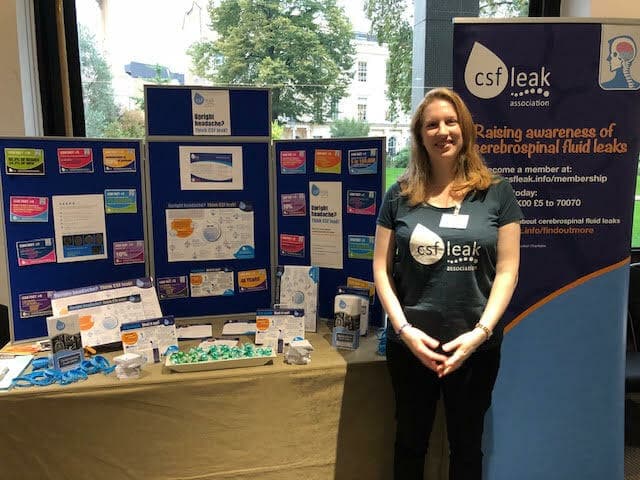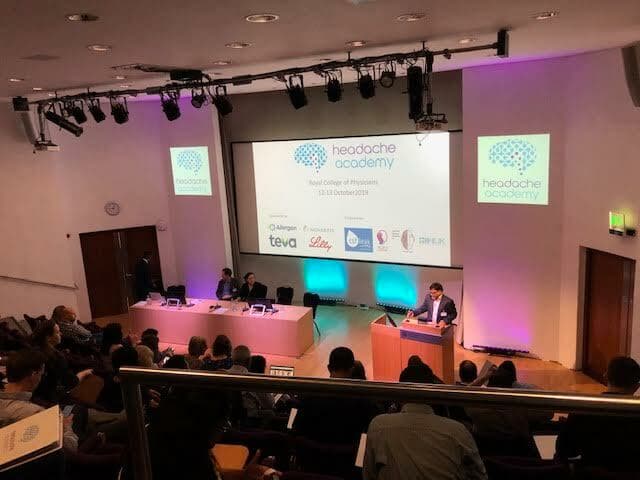An insightful event
The CSF Leak Association was delighted to be invited back to endorse and attend the 2019 Headache Academy at the Royal College of Physicians in London. It was the second specialist teaching weekend on headache disorders organised by Dr Matharu. The foremost headache experts in the country were invited to speak and give case presentations.
The aim of the event was to help clinicians to:
- Learn how to diagnose major categories of headache accurately
- Manage headache disorders more effectively
- Understand the evidence base for currently available treatments
- Develop effective, individualised treatment plans for patients.
In attendance were 120 delegates made up of Specialist Registrars in Neurology, Paediatrics, Emergency Medicine and General Practice along with Headache Specialist Nurses and researchers.
Clare Joy and I arrived early to furnish our stand with leaflets, posters and factsheets and after wrestling with the pop up banner which has a mind of its own we were ready for the delegates.
Opposite us were Shelly and Norma from Idiopathic Intracranial Hypotension (IIH) UK and it was a great pleasure to catch up with them and find out what their charity has been up to since we last met. We were pleased to see the sofas that had been such a comfortable resting place last year were still there but we were determined to do our best to listen to as many talks as we could from the packed program.
Dr Manjit Matharu (Consultant Neurologist, National Hospital for Neurology and Neurosurgery, London) began with an interesting introduction and overview of headaches, stating that they are common, highly disabling, often misdiagnosed and under-treated. Effective treatment he said depended on correct diagnosis and as headache disorders have a large differential diagnosis they need to be approached systematically.
We were delighted to hear that due to the interest shown in Spontaneous Intracranial Hypotension ( SIH ) by the delegates at last year’s Headache Academy, this year there was to be a dedicated presentation on SIH given by Dr Alok Tyagi (Consultant Neurologist, Queen Elizabeth Hospital Glasgow).
He began the presentation by describing conditions which can have similar symptoms to SIH, these being :
- Migraine
- Thunderclap headache
- Valsalva or Cough headache
- Positional rather than orthostatic headache
- Postural Orthostatic Tachycardia Syndrome ( POTS )
- Colloid cyst
He emphasised the importance of establishing that the headache is definitely orthostatic as positional headaches can be confused with postural ones. He recounted a previous presentation by Dr Callum Duncan (Consultant Neurologist, Aberdeen Royal Infirmary). This was a case study of a patient who appeared at first to have classic symptoms of a leak, i.e. a postural headache which improved when lying down. After further investigation however, it was discovered the patient had a positional headache caused by occipital condyle syndrome. The patient’s headache only improved when lying down on his left side rather than lying down in any position.
Dr Tyagi explained that orthostatic features can disappear with time so if a patient presents with chronic daily persistent headache he suggested asking what the headache was like when it first started to find out if there were orthostatic features at the outset.
He summarised the symptoms we are all familiar with then outlined the causes, these being: Surgical, Osteophytes or trauma. He noted the association spinal leaks have with Ehlers Danlos Syndrome particularly patients with lax skin and hypermobile joints.
He went on to say that although he would like to think that it was the acumen of neurologists that had led to an increase in patients being diagnosed with SIH but it was in fact due to advances in MRI scanning. The most commonly reported abnormality seen in SIH patients on an head MRI is diffuse pachymeningeal (dural) enhancements, followed by descent of the brain, enlargement of the pituitary, subdural fluid collections and engorged cerebral venous sinuses. He reported that 1 in 5 patients with SIH can have a normal MRI and the longer the duration of symptoms the less likely changes such as dural enhancements will be seen.
He advised that measuring CSF opening pressure is not a reliable method of identifying SIH as it can be normal in more than 60% cases but if a lumbar puncture needs to be done for other reasons and CSF pressure is measured and found to be less than 6cm water this would indicate SIH.


Highlighted case studies
Dr Tyagi continued by describing three case studies:
- The first was diagnosed within days of onset and after one blood patch there was a complete recovery. This he stated was the desired outcome; early diagnosis and treatment leading to full recovery.
- In the second case it took longer to recognise the cause and two blood patches were needed to enable the patient to return to work. Although residual symptoms remained, the patient chose not to have a third patch at this time.
- In the third case several patches failed to give any significant relief. He stated this patient needed to be referred on to a specialist center with more experience of SIH.
He then set out the different types of spinal leaks stating that spontaneous leaks could be broadly classified into 4 types:
- Dural tears - usually ventral and less commonly dorso-lateral
- Meningeal diverticulum
- CSF Venous fistula
- Indeterminate / unknown
His take home message to the delegates was:
- SIH normally presents with orthostatic headaches but it can also present as chronic daily headaches.
- If SIH is suspected, ask for an MRI of the head with contrast.
- A lumbar epidural blood patch should be considered as soon as a diagnosis is certain.
- If there is no response to blood patches, send on to a Specialist Centre where they are better able to identify the site of the CSF leak and to treat with a targeted blood patch or surgery.
On the second day, Dr Jenny Pople came along to join me on the stand. It was a great pleasure to meet Jenny as I have long admired the work she does for the charity in producing the quarterly research review which is published on the CSF Leak Association website.
Watching the presentations gave an insight into the difficulties in diagnosing the different types of headaches and deciding on the appropriate treatment. We were encouraged by the requests for information about CSF Leaks and the genuine desire of the delegates to help those suffering with them. We were particularly delighted by the interest shown in the Charity’s bursary to attend the 2020 CSF Leak Symposium in the USA .
We are extremely grateful to Dr Matharu for organising this event, inviting Dr Tyagi to give a presentation on SIH and for inviting the CSF Leak Association to attend. It has been an effective method of improving awareness of CSF leaks amongst the specialists who gave up their weekends to learn how to improve the healthcare provision to their patients. As knowledge of CSF leaks continues to grow, more people will benefit from quicker diagnosis and treatment, leading to increasing numbers of successful outcomes.
Clare Sergeant
